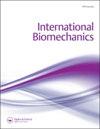Effects of a semi-rigid ankle brace on ankle joint loading during landing on inclined surfaces
Q2 Medicine
引用次数: 5
Abstract
ABSTRACT Ankle bracing is commonly used to prevent ankle sprain occurrences. The present study investigated the effects of a semi-rigid ankle brace on the ankle joint complex during landing on inclined surfaces. Seventeen recreational athletes performed a single leg landing task onto three different surface alignments (everted, neutral, inverted), with and without the brace. Ground reaction forces (GRF), kinematics, and brace pressure were recorded. Six two-way repeated measures MANOVA tested for differences in GRF, talocrural and subtalar kinematics and kinetics. Participants landed with a significantly less plantar flexed (P < 0.001) and more everted (P = 0.001) foot during the braced condition. Although no differences were observed for the joint moments, an increased subtalar compression force (P = 0.009) was observed with the brace. Landing on the inverted surface resulted in significantly higher peak magnitudes of the vertical and the mediolateral GRF and the talocrural inversion moment compared to landing on the neutral surface. Ankle bracing altered ankle kinematics by restricting the ROM of the ankle joint complex. This study confirmed that landing on inverted surfaces may increase the risk for lateral ankle ligaments injuries. The significantly higher subtalar compression force during the brace condition might contribute to overuse injuries.半刚性踝关节支架在倾斜表面着陆时对踝关节载荷的影响
踝关节支具是预防踝关节扭伤的常用手段。本研究探讨了半刚性踝关节支架在倾斜表面着陆时对踝关节复合体的影响。17名休闲运动员进行了单腿着地任务,在三种不同的表面对齐(倾斜、中立、倒置)上,有和没有支架。记录地面反作用力(GRF)、运动学和支撑压力。六种双向重复测量方差分析测试了GRF、距骨和距下运动学和动力学的差异。在支撑条件下,参与者着地时足底屈曲明显减少(P < 0.001),而脚掌外翻明显增加(P = 0.001)。虽然没有观察到关节力矩的差异,但观察到支架增加了距下压缩力(P = 0.009)。降落在倒立表面时,垂直、中外侧GRF峰值和距地逆转力矩显著高于降落在中性表面时。踝关节支架通过限制踝关节复合体的ROM改变踝关节的运动学。这项研究证实,在倒置的表面着陆可能会增加踝关节外侧韧带损伤的风险。在支具状态下明显较高的距下压迫力可能导致过度使用损伤。
本文章由计算机程序翻译,如有差异,请以英文原文为准。
求助全文
约1分钟内获得全文
求助全文
来源期刊

International Biomechanics
Medicine-Rehabilitation
CiteScore
1.90
自引率
0.00%
发文量
2
审稿时长
17 weeks
期刊介绍:
International Biomechanics is a fully Open Access biomechanics journal that aims to foster innovation, debate and collaboration across the full spectrum of biomechanics. We publish original articles, reviews, and short communications in all areas of biomechanics and welcome papers that explore: Bio-fluid mechanics, Continuum Biomechanics, Biotribology, Cellular Biomechanics, Mechanobiology, Mechano-transduction, Tissue Mechanics, Comparative Biomechanics and Functional Anatomy, Allometry, Animal locomotion in biomechanics, Gait analysis in biomechanics, Musculoskeletal and Orthopaedic Biomechanics, Cardiovascular Biomechanics, Plant Biomechanics, Injury Biomechanics, Impact Biomechanics, Sport and Exercise Biomechanics, Kinesiology, Rehabilitation in biomechanics, Quantitative Ergonomics, Human Factors engineering, Occupational Biomechanics, Developmental Biomechanics.
 求助内容:
求助内容: 应助结果提醒方式:
应助结果提醒方式:


